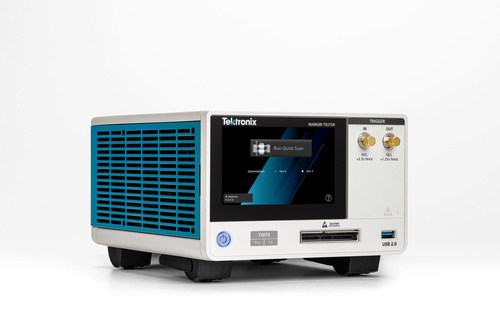Tek launches its new PCIe Margin Tester
Tektronix is claiming that it has a new product category that provides disruptive capabilities and cost for PCI Express testing, saying that its newly unveiled Margin Tester takes a “completely new approach to PCIe validation testing.”
In a demonstration video, Tek applications engineer Evan Smith explained that the tester is aimed at PCI3 Gen 3 and Gen 4 testing and determines the link health of designs faster, more easily and more effectively so that problems can be uncovered earlier in development. The new instrument isn’t an oscilloscope, a bit error rate tester (BERT) or a protocol analyzer, he said, but has elements of each one and could be considered a new PCIe testing tool that complements other instruments and addresses associated pain points with PCIe testing.
Tek says that the instrument has a plug-and-play set-up and is easy to use, capable of delivering “in minutes” testing that typically would take hours or days to set up and conduct.
Chris Witt, VP and GM of portfolio solutions at Tektronix, said that the TMT4 Margin Tester “empowers engineers to realize technological advances with ever greater ease and speed.”
In other test news:
–Keysight Technologies, Synopsys and Ansys are focusing on support for millimeter-wave development of 5G/6G system-on-chip designs. The three companies announced this week that availability of their newmmWave RF design flow for TSMC’s 16nm FinFET Compact (16FFC) technology for high-speed SoC design.
“Today’s high-speed designs need to address an increasing range of multi-physics effects to optimize power, area, reliability and performance,” said John Lee, vice president and general manager of the electronics, semiconductor, and optics business unit at Ansys, adding, “The collaborative mmWave design reference flow using TSMC’s 16FFC technology is a successful example that streamlines access to advanced silicon design and manufacturing for 5G and wireless products by bringing together Synopsys’ Custom Design Family with Keysight’s premier RF design capabilities and Ansys’ multiphysics signoff solutions for power integrity and electromagnetic analysis.”
“Semiconductor industry megatrends for wireless communication are increasing RF and mmWave content in HPC, smartphone, automotive, and IoT applications,” said Dan Kochpatcharin, head of the design infrastructure management division at TSMC. “Such complex designs require extensive ecosystem collaboration to help designers achieve silicon success with well-established solutions. The mmWave design reference flow that Synopsys, Ansys and Keysight have developed for TSMC’s 16FFC process benefits from its superior performance and power consumption advantage for a tightly integrated solution that enhances productivity and quality-of-results for 5G/6G SoCs.”
–Rohde & Schwarz said this week that voice and audio analysis expert HEAD acoustics will use R&S’ CMX500 5G test solution to analyze and verify voice and audio services in 5G devices. Additionally, the test company is already working on partnerships and supporting research with an eye toward future 6G systems: It reported that it worked with China’s Tsinghua University and Chinese firm Actenna Technology to test reconfigurable intelligent surfaces (RIS), which it said is a “major area of interest in 6G research”.
“The technical trial mainly evaluated the deployment effects and performance of sub-6 GHz RIS and mmWave RIS in different indoor and outdoor scenarios,” Rohde & Schwarz explained in a release, saying that the tests “modeled deployment conditions with and without RIS, different incidence and reflection angles, different deployment distances, etc. Recorded performance index parameters included RSRP, throughput and others.” The trial included both indoor and outdoor tests and included both a 860mm x 860mm sub-6 GHz RIS 20×20 element array, and a 180mm x 180mm mmWave RIS arraywith 32×32 elements. Various R&S instruments were used in the tests, including Rohde’s SMW200A vector signal generator and its TSMx drive test scanner, plus its QualiPoc software and drive test terminals and an R&S FSW signal and spectrum analyzer, among others.
R&S said that the trial “[yielded] hard data that makes a strong argument in favor of continued RIS technology development.”
-Enterprise networking company OneLayer is opening a 5G private network security lab.
-Meanwhile, in Taiwan, UL Solutions has opened a new state-of-the-art automotive electromagnetic compatibility (EMC) laboratory in Hsinchu, which includes testing capabilities for IoT and various RF applications.

“With the opening of this laboratory, combined with the UL Solutions Internet of Things (IoT) Lab in Hsinchu and the E-mobility and Energy Laboratory in Taoyuan, we are confident that the testing capabilities offered by UL Solutions for automotive components will provide manufacturers in Taiwan with a complete range of testing services and a single source of service,” said Jonathan TH Chen, VP and managing director of UL Solutions in Taiwan, said. “Our professional testing technologies and quality services meet the latest international standards and help enable manufacturers in Taiwan to enter the global automotive electronic component market safely and quickly.”


